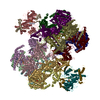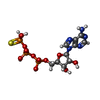[English] 日本語
 Yorodumi
Yorodumi- PDB-7pt6: Structure of MCM2-7 DH complexed with Cdc7-Dbf4 in the presence o... -
+ Open data
Open data
- Basic information
Basic information
| Entry | Database: PDB / ID: 7pt6 | |||||||||||||||
|---|---|---|---|---|---|---|---|---|---|---|---|---|---|---|---|---|
| Title | Structure of MCM2-7 DH complexed with Cdc7-Dbf4 in the presence of ATPgS, state III | |||||||||||||||
 Components Components |
| |||||||||||||||
 Keywords Keywords | REPLICATION / Helicase / Activation / Kinase / Phosphorylation | |||||||||||||||
| Function / homology |  Function and homology information Function and homology informationpositive regulation of spindle attachment to meiosis I kinetochore / positive regulation of meiotic DNA double-strand break formation involved in reciprocal meiotic recombination / positive regulation of kinetochore assembly / positive regulation of meiotic DNA double-strand break formation / positive regulation of DNA replication initiation / negative regulation of exit from mitosis / Dbf4-dependent protein kinase complex / positive regulation of protein localization to kinetochore / positive regulation of meiosis I / positive regulation of nuclear cell cycle DNA replication ...positive regulation of spindle attachment to meiosis I kinetochore / positive regulation of meiotic DNA double-strand break formation involved in reciprocal meiotic recombination / positive regulation of kinetochore assembly / positive regulation of meiotic DNA double-strand break formation / positive regulation of DNA replication initiation / negative regulation of exit from mitosis / Dbf4-dependent protein kinase complex / positive regulation of protein localization to kinetochore / positive regulation of meiosis I / positive regulation of nuclear cell cycle DNA replication / regulation of cell cycle phase transition / MCM core complex / Assembly of the pre-replicative complex / Switching of origins to a post-replicative state / MCM complex binding / mitotic DNA replication preinitiation complex assembly / nuclear DNA replication / premeiotic DNA replication / replication fork protection complex / pre-replicative complex assembly involved in nuclear cell cycle DNA replication / Activation of the pre-replicative complex / mitotic DNA replication / CMG complex / nuclear pre-replicative complex / Activation of ATR in response to replication stress / DNA replication preinitiation complex / MCM complex / protein-containing complex localization / mitotic DNA replication checkpoint signaling / double-strand break repair via break-induced replication / mitotic DNA replication initiation / single-stranded DNA helicase activity / silent mating-type cassette heterochromatin formation / regulation of DNA-templated DNA replication initiation / DNA strand elongation involved in DNA replication / nuclear replication fork / DNA replication origin binding / chromosome, centromeric region / DNA replication initiation / subtelomeric heterochromatin formation / DNA helicase activity / protein serine/threonine kinase activator activity / chromosome segregation / transcription elongation by RNA polymerase II / helicase activity / heterochromatin formation / single-stranded DNA binding / DNA helicase / chromosome, telomeric region / DNA replication / non-specific serine/threonine protein kinase / cell division / protein serine kinase activity / protein serine/threonine kinase activity / DNA damage response / centrosome / chromatin binding / chromatin / signal transduction / ATP hydrolysis activity / zinc ion binding / nucleoplasm / ATP binding / metal ion binding / identical protein binding / nucleus / cytoplasm Similarity search - Function | |||||||||||||||
| Biological species |  | |||||||||||||||
| Method | ELECTRON MICROSCOPY / single particle reconstruction / cryo EM / Resolution: 3.2 Å | |||||||||||||||
 Authors Authors | Saleh, A. / Noguchi, Y. / Aramayo, R. / Ivanova, M.E. / Speck, C. | |||||||||||||||
| Funding support |  United Kingdom, 4items United Kingdom, 4items
| |||||||||||||||
 Citation Citation |  Journal: Nat Commun / Year: 2022 Journal: Nat Commun / Year: 2022Title: The structural basis of Cdc7-Dbf4 kinase dependent targeting and phosphorylation of the MCM2-7 double hexamer. Authors: Almutasem Saleh / Yasunori Noguchi / Ricardo Aramayo / Marina E Ivanova / Kathryn M Stevens / Alex Montoya / S Sunidhi / Nicolas Lopez Carranza / Marcin J Skwark / Christian Speck /  Abstract: The controlled assembly of replication forks is critical for genome stability. The Dbf4-dependent Cdc7 kinase (DDK) initiates replisome assembly by phosphorylating the MCM2-7 replicative helicase at ...The controlled assembly of replication forks is critical for genome stability. The Dbf4-dependent Cdc7 kinase (DDK) initiates replisome assembly by phosphorylating the MCM2-7 replicative helicase at the N-terminal tails of Mcm2, Mcm4 and Mcm6. At present, it remains poorly understood how DDK docks onto the helicase and how the kinase targets distal Mcm subunits for phosphorylation. Using cryo-electron microscopy and biochemical analysis we discovered that an interaction between the HBRCT domain of Dbf4 with Mcm2 serves as an anchoring point, which supports binding of DDK across the MCM2-7 double-hexamer interface and phosphorylation of Mcm4 on the opposite hexamer. Moreover, a rotation of DDK along its anchoring point allows phosphorylation of Mcm2 and Mcm6. In summary, our work provides fundamental insights into DDK structure, control and selective activation of the MCM2-7 helicase during DNA replication. Importantly, these insights can be exploited for development of novel DDK inhibitors. | |||||||||||||||
| History |
|
- Structure visualization
Structure visualization
| Structure viewer | Molecule:  Molmil Molmil Jmol/JSmol Jmol/JSmol |
|---|
- Downloads & links
Downloads & links
- Download
Download
| PDBx/mmCIF format |  7pt6.cif.gz 7pt6.cif.gz | 1.6 MB | Display |  PDBx/mmCIF format PDBx/mmCIF format |
|---|---|---|---|---|
| PDB format |  pdb7pt6.ent.gz pdb7pt6.ent.gz | Display |  PDB format PDB format | |
| PDBx/mmJSON format |  7pt6.json.gz 7pt6.json.gz | Tree view |  PDBx/mmJSON format PDBx/mmJSON format | |
| Others |  Other downloads Other downloads |
-Validation report
| Summary document |  7pt6_validation.pdf.gz 7pt6_validation.pdf.gz | 2.1 MB | Display |  wwPDB validaton report wwPDB validaton report |
|---|---|---|---|---|
| Full document |  7pt6_full_validation.pdf.gz 7pt6_full_validation.pdf.gz | 2.2 MB | Display | |
| Data in XML |  7pt6_validation.xml.gz 7pt6_validation.xml.gz | 237.2 KB | Display | |
| Data in CIF |  7pt6_validation.cif.gz 7pt6_validation.cif.gz | 359.6 KB | Display | |
| Arichive directory |  https://data.pdbj.org/pub/pdb/validation_reports/pt/7pt6 https://data.pdbj.org/pub/pdb/validation_reports/pt/7pt6 ftp://data.pdbj.org/pub/pdb/validation_reports/pt/7pt6 ftp://data.pdbj.org/pub/pdb/validation_reports/pt/7pt6 | HTTPS FTP |
-Related structure data
| Related structure data |  13619MC  7pt7C M: map data used to model this data C: citing same article ( |
|---|---|
| Similar structure data | Similarity search - Function & homology  F&H Search F&H Search |
- Links
Links
- Assembly
Assembly
| Deposited unit | 
|
|---|---|
| 1 |
|
- Components
Components
-Protein/peptide , 1 types, 2 molecules 1A
| #1: Protein/peptide | Mass: 358.434 Da / Num. of mol.: 2 Source method: isolated from a genetically manipulated source Source: (gene. exp.)  Strain: ATCC 204508 / S288c / Production host:  |
|---|
-DNA replication licensing factor ... , 5 types, 10 molecules 2B3C4D6F7G
| #2: Protein | Mass: 98911.539 Da / Num. of mol.: 2 Source method: isolated from a genetically manipulated source Source: (gene. exp.)  Strain: ATCC 204508 / S288c / Gene: MCM2, YBL023C, YBL0438 / Production host:  #3: Protein | Mass: 107653.508 Da / Num. of mol.: 2 Source method: isolated from a genetically manipulated source Source: (gene. exp.)  Strain: ATCC 204508 / S288c / Gene: MCM3, YEL032W, SYGP-ORF23 / Production host:  #4: Protein | Mass: 105138.375 Da / Num. of mol.: 2 Source method: isolated from a genetically manipulated source Source: (gene. exp.)  Strain: ATCC 204508 / S288c / Gene: MCM4, CDC54, HCD21, YPR019W, YP9531.13 / Production host:  #6: Protein | Mass: 113110.211 Da / Num. of mol.: 2 Source method: isolated from a genetically manipulated source Source: (gene. exp.)  Strain: ATCC 204508 / S288c / Gene: MCM6, YGL201C / Production host:  #7: Protein | Mass: 95049.875 Da / Num. of mol.: 2 Source method: isolated from a genetically manipulated source Source: (gene. exp.)  Strain: ATCC 204508 / S288c / Gene: MCM7, CDC47, YBR202W, YBR1441 / Production host:  |
|---|
-Protein , 3 types, 6 molecules 5E8H9I
| #5: Protein | Mass: 86505.734 Da / Num. of mol.: 2 Source method: isolated from a genetically manipulated source Source: (gene. exp.)  Strain: ATCC 204508 / S288c / Gene: MCM5, CDC46, YLR274W, L9328.1 / Production host:  #8: Protein | Mass: 58391.129 Da / Num. of mol.: 2 Source method: isolated from a genetically manipulated source Source: (gene. exp.)  Strain: ATCC 204508 / S288c / Gene: CDC7, OAF2, YDL017W, D2855 / Production host:  References: UniProt: P06243, non-specific serine/threonine protein kinase #9: Protein | Mass: 80824.156 Da / Num. of mol.: 2 Source method: isolated from a genetically manipulated source Source: (gene. exp.)  Strain: ATCC 204508 / S288c / Gene: DBF4, DNA52, YDR052C, D4205, YD9609.07C / Production host:  |
|---|
-Non-polymers , 4 types, 44 molecules 






| #10: Chemical | ChemComp-AGS / #11: Chemical | ChemComp-MG / #12: Chemical | ChemComp-ZN / #13: Chemical | ChemComp-ADP / |
|---|
-Details
| Has ligand of interest | Y |
|---|
-Experimental details
-Experiment
| Experiment | Method: ELECTRON MICROSCOPY |
|---|---|
| EM experiment | Aggregation state: PARTICLE / 3D reconstruction method: single particle reconstruction |
- Sample preparation
Sample preparation
| Component | Name: MCM2-7 double hexamer bound to two copies of Cdc7-Dbf4 Type: COMPLEX / Entity ID: #1-#9 / Source: RECOMBINANT |
|---|---|
| Molecular weight | Value: 1.5 MDa / Experimental value: NO |
| Source (natural) | Organism:  |
| Source (recombinant) | Organism:  |
| Buffer solution | pH: 7.5 |
| Specimen | Embedding applied: NO / Shadowing applied: NO / Staining applied: NO / Vitrification applied: YES |
| Specimen support | Details: 15 mA / Grid material: COPPER / Grid mesh size: 300 divisions/in. / Grid type: Quantifoil R2/2 |
| Vitrification | Instrument: FEI VITROBOT MARK IV / Cryogen name: ETHANE / Humidity: 100 % / Chamber temperature: 277 K / Details: blot for 1.5 seconds and blot force +2 |
- Electron microscopy imaging
Electron microscopy imaging
| Experimental equipment |  Model: Titan Krios / Image courtesy: FEI Company |
|---|---|
| Microscopy | Model: FEI TITAN KRIOS |
| Electron gun | Electron source:  FIELD EMISSION GUN / Accelerating voltage: 300 kV / Illumination mode: FLOOD BEAM FIELD EMISSION GUN / Accelerating voltage: 300 kV / Illumination mode: FLOOD BEAM |
| Electron lens | Mode: BRIGHT FIELD / Nominal magnification: 81000 X / Cs: 2.7 mm / Alignment procedure: COMA FREE |
| Specimen holder | Cryogen: NITROGEN / Specimen holder model: FEI TITAN KRIOS AUTOGRID HOLDER |
| Image recording | Electron dose: 45.9 e/Å2 / Film or detector model: GATAN K3 (6k x 4k) / Num. of real images: 9909 |
- Processing
Processing
| EM software |
| ||||||||||||||||||||||||
|---|---|---|---|---|---|---|---|---|---|---|---|---|---|---|---|---|---|---|---|---|---|---|---|---|---|
| CTF correction | Type: PHASE FLIPPING ONLY | ||||||||||||||||||||||||
| Symmetry | Point symmetry: C2 (2 fold cyclic) | ||||||||||||||||||||||||
| 3D reconstruction | Resolution: 3.2 Å / Resolution method: FSC 0.143 CUT-OFF / Num. of particles: 73093 Details: Multi-body auto-refined maps were combined to generate a composite map using an atomic model (derived from MD-(ATPgS) state III), with the program combine_focused_maps in Phenix Symmetry type: POINT |
 Movie
Movie Controller
Controller


























 PDBj
PDBj






